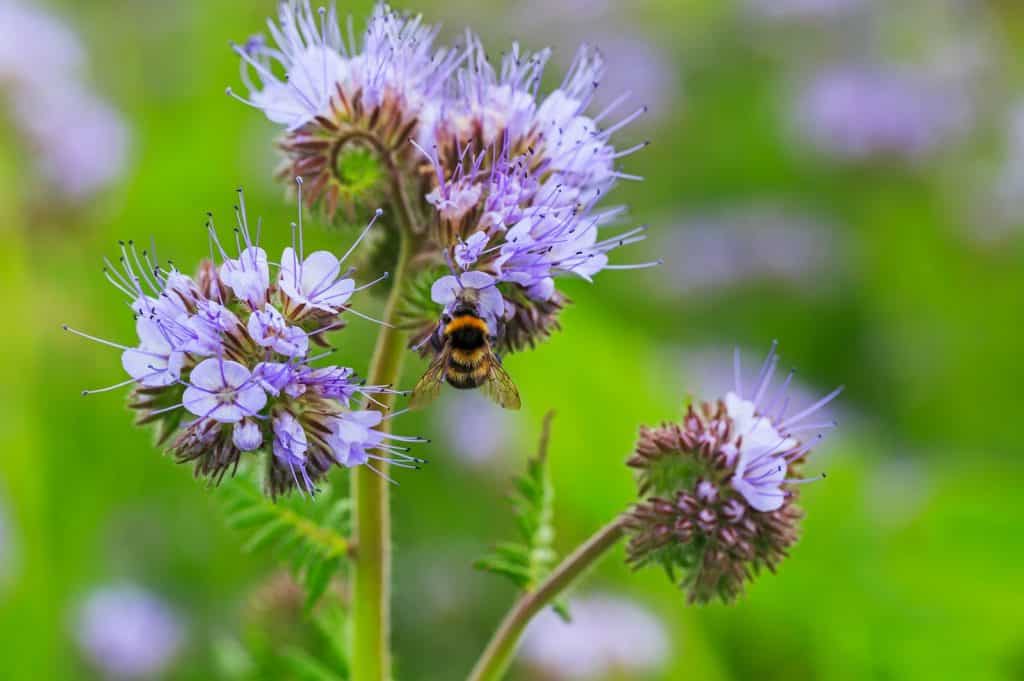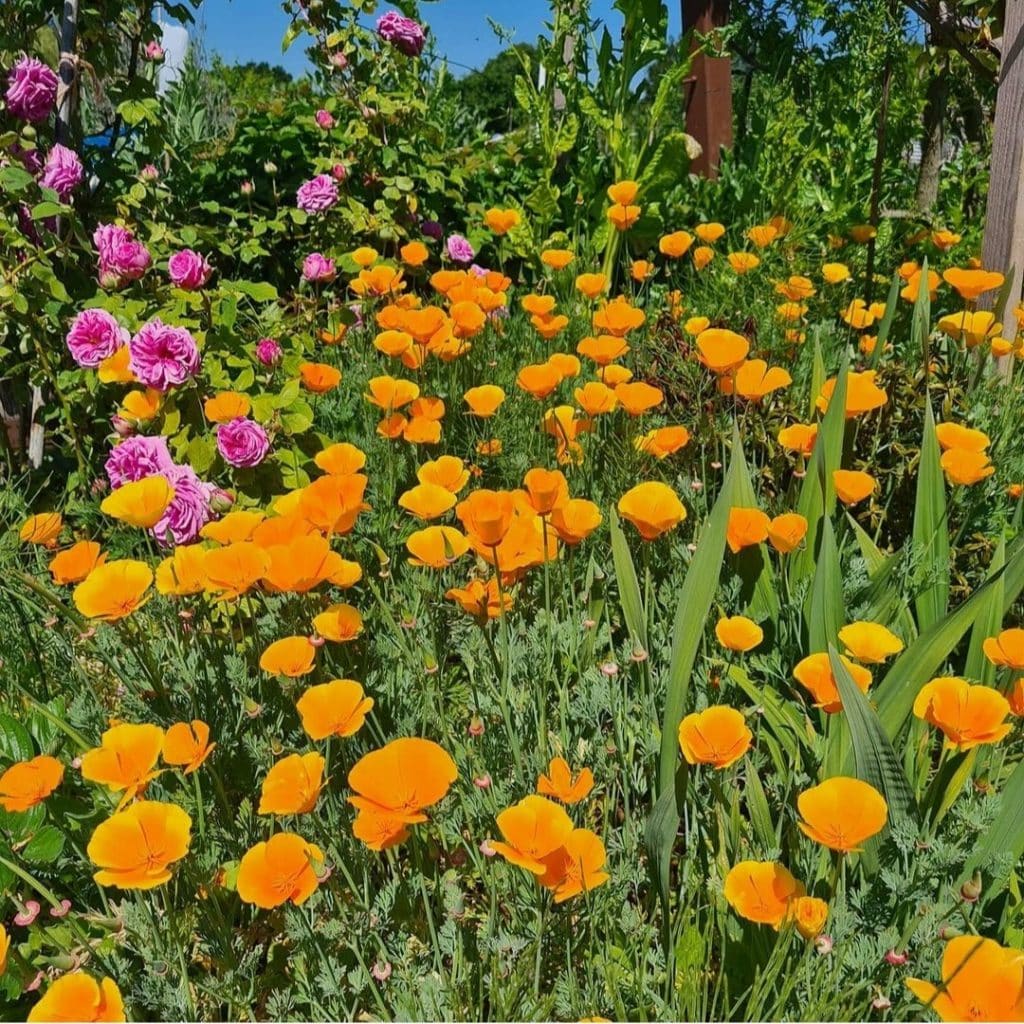Annuals & Biennials
Why Use Annuals & Biennials
When I first started designing gardens I would always be confused as to whether I should use annuals and biennials in my planting scheme. However, as an experienced garden designer I now know that annuals and biennials truly have their place in the garden. Creating a garden is not cheap. My advice is to take your time. Put in your structural plants such as trees and shrubs. Using annuals is a cost-effective way to get colour in the garden but it buys time for making decisions of which other plants you would like to establish in the garden.
What I also find very useful about using annuals and biennials is that they are perfect to use as fillers in those annoying gaps where maybe a group of bulbs have now faded away. They also come in handy for mixing into containers. Be diligent with your dead heading and they will keep performing and producing blooms for some time.

Photo Credit: Manoj Malde
These Welsh poppies (Meconopsis cambrica) self-seed in my garden and I let them grow wherever they want. They are joyful and bring a spark of colour in the garden.
What Are Annuals
Annuals are plants that complete their full growth cycle from germination through to growth, setting seed and then dying within one year. Annuals provide a lot of colours in the garden. They are either bought as seed or collected as seed from the previous year’s plants. Nurseries will also sell them as bedding plants. Certain annuals are fussy. They do not like too much handling and transplanting. It is best to grow these straight into the ground where you intend them to grow.
What Are Biennials
Biennials are also cheap to grow from seed. They have a two-year life cycle. These plants germinate and usually form a rosette. The plant spends the first year storing energy to put on growth in the second year forming a flower stalk and bursting into bloom. Thereafter the plant will set seed. Once the seed has been dispersed the plant will die back.

Zinnia will provide a rainbow of colours in the garden as the come is a variety of colours. This is Zinnia elegans Queen Lime Orange. Similar to Queen Red lime the petals have an ombre effect by fading as they get to the centre then it had the deep red colour in the very middle.
Sowing Annuals
Annuals can be sown in autumn so long as you have indoor storage through the winter months. Sowing in autumn will give you an earlier flowering display. However, they can also be sown in spring which will give you a later flowering display. Some hardy annuals can withstand frost so these can be sown directly in the ground in a fine tilth soil. If sowing half-hardy or tender annuals you will need a heated greenhouse, otherwise it is best to sow them in spring. When sowing seeds, it is best not to use rich compost or highly nutritious soil as you will end up with a lot of leafy growth and weak plants.

Photo Credit: Manoj Malde
Tithonia rotundifolia are very easy to grow and will provide masses of flowers for a long period. Their height makes them a good plant for the back of the border. It is also easy to save the seed to grow again for the following year.
Sowing Biennials
The best time to sow biennials is in early summer. Sowing them in June or July allows them to put on good root growth and form the rosette of foliage on top in their first year. Whilst biennials can be grown directly into soil, and I do shake my digitalis seed heads straight into the borders, it does make more sense to sow them in pot. This will give you some control over them. Trying weeding around delicate seedlings. It is a helpless task. In September you can position the plants out in the borders exactly where you want them. The soil is still warm so they will get their roots well established in the ground before the garden goes into its winter slumber.
Choice Annuals & Biennials to Grow
There is an abundance of annuals and biennials that are easy to grow from seed but here is just a small list that you might like to try
Phacelia tanacetifolia
Is a robust annual with finely cut fern like leaves that grow very densely. It bears curved flower spikes of small lavender coloured bell shape flowers. A very easy and worthwhile annual to grow as it attracts bees and can be used as a green manure.
Height: 90cm.
Flowering Period: June to September

There are many benefits to growing Phacelia tanacetifolia. Apart from the lavender flowers on the curling stems looking very pretty, this plant is both beneficial to wildlife and can be used a green manure.
Photo Credit: Manoj Malde
Tithonia rotundifolia Torch
A very easy annual to grow and deserving of more recognition. Growing as tall, compact plants with large, almost heart shaped leaves. The plants flower freely producing lots of single bloom Dahlia like flowers in rich saffron orange. Beneficial for wildlife.
Height: 120cm
Flowering Period: July to October
Zinnia elegans Queen Red Lime
Zinnias are exceptional and the Queen Lime range has to be my favourite. They provide a kaleidoscope of colours. Queen Red Lime is so aristocratic in its colouration. Pale red outer petals fade to a vintage lime, reaching a maroon centre. Double bloom flowers blooms on tall stems making them perfect for cut flowers. They do not like disturbance so best sown where they are to grow.
Height: 75cm
Flowering Period: June to October.

Photo Credit: Manoj Malde
Zinnia in the borders at Ashton Pottery, with the burgundy plumes of Amaranthus in the back. Ashton Nursery grow so many of their plants by seed. It is well worth a visit to enjoy the kaleidoscope of colours.
Scabiosa stellata Sternkugel
The star attraction of this scabiosa are its unusual seed heads. The flowers a dusty pale blue tightly packed together in a spherical shape with a creamy pin-cushion centre flecked with pink. The stems rise above the foliage. The flowers turn into creamy-white globular seed heads that look like they are made from parchment.
Height: 70cm
Flowering Period: April to June

Seed head of Scabiosa stellate Sternkugel that looks like it has been formed in parchment. If the little starry centres could light up it would make a beautiful Christmas tree decoration.
Eschscholzia californica Apricot Chiffon (Thai Silk Series)
Californian poppies are easy to grow putting on a colourful show throughout summer. They have lovely rich colours. The flowers grow as both double and single blooms. They petals look like plisse Thai silk. The plants have finely cut blue-grey feathery foliage. Californian poppies like poor well drained soil and full sun making them perfect for Mediterranean style gravel gardens.
Height: 25cm
Flowering Period: June to September
Panicum elegans Frosted Explosion
I first came across this annual at Beth Chatto Garden. It is a beautiful grass that is sown as an annual and gives a real airy, meadowy look at the front of borders. When the plumes appear, they look like fibre optics. It prefers moist but well-drained soil in full sun or light shade. It is easy to grow and well worth a try.
Height: 45cm
Flowering Period: July to October

Photo Credit: Manoj Malde
There are various varieties of Californian poppies, and all are worth trying. They provide wonderful colour in the garden and will self-seed.
Digitalis purpurea Pam’s Choice (Foxglove Pam’s Choice)
This Foxglove has a real elegance. It produces a dense flower spike with white tubular bell shaped flowers with throats that are extravagantly marked with deep burgundy blotches. Will grow in full sun or part shade. This is a good choice for naturalising in shade.
Height: 120cm
Flowering Period: May to July
Dianthus barbatus (Sweet William)
Sweet William come in a variety of colour from white, pale pink, cerise, reds through to a dark sooty colour and bi-colour combinations. Easy to grow and perfect for a cottage style garden. Sweet William are extremely scented, they make great cut flowers and are prolific self-seeders. They prefer a light soil in full sun and will not tolerate wet soil in winter.
Height: 45cm
Flowering Period: May to September
Hesperis matronalis (Sweet Rocket)
Although a perennial it is best grown as a biennial. Worth growing for its beautiful perfume. Sweet Rocket is suitable for informal herbaceous borders. The flowers bloom in lilac or white forming loose clusters. Beneficial for bees and other insects. They will self-seed freely. Will grow in full sun but best in partial shade. They prefer a moist but well-drained soil.
Height: 90cm
Flowering Period: May to August

If you like scent in the garden Hesperis matronalis is worth growing. Commonly known as Sweet Rocket it is also edible so can be used to add colour to salad by sprinkling on top.
Lunaria annua (Honesty)
Apart from the flowers one of the attractions of Honesty is the translucent flat over shaped seed heads that remain on the plant well into autumn. This biennial will self-seed and attracts bees and butterflies. It is the perfect plant for naturalising in a wild garden, meadow, or woodland edge. The flowers bloom in white or lilac and are scented. Prefers a moist well-drained soil and partial shade.
Height: 75cm
Flowering Period: April to July

Translucent seed heads of Honesty. The flowers are also pretty and beneficial to wildlife. Honesty will also provide scent in the garden.
Smyrnium perfoliatum
Another great plant for the woodland edge. Their upright stems and the delicate looking flowers make them great fillers in flower arrangements. The tiny flowers grow in a circular clusters. The lime green colours of this plant make it the perfect foil for jewel plums, purples, and burgundies. They will also self-seed
Height: 80 to 90cm
Flowering Period: May to June

If you enjoy cut flowers from your garden this is a useful plant to use in a floral arrangement. The sulphurous colour makes them an excellent foil for rich dark jewel colours
Anthriscus sylvestris Ravenswing (Cow Parsley)
A purple form of cow parsley. It is both elegant and delicate with its pretty clusters of tiny creamy-white flowers that sit above lacy, finely cut purple foliage. This biennial is short lived but will self-seed freely. Appropriate wild gardens and meadows and sits well with grasses.
Height: 90 to100cm
Flowering Period: April to July
Seed Suppliers
Chiltern Seeds
https://www.chilternseeds.co.uk/
Higgledy Garden
Sutton Seeds
https://www.suttons.co.uk/



